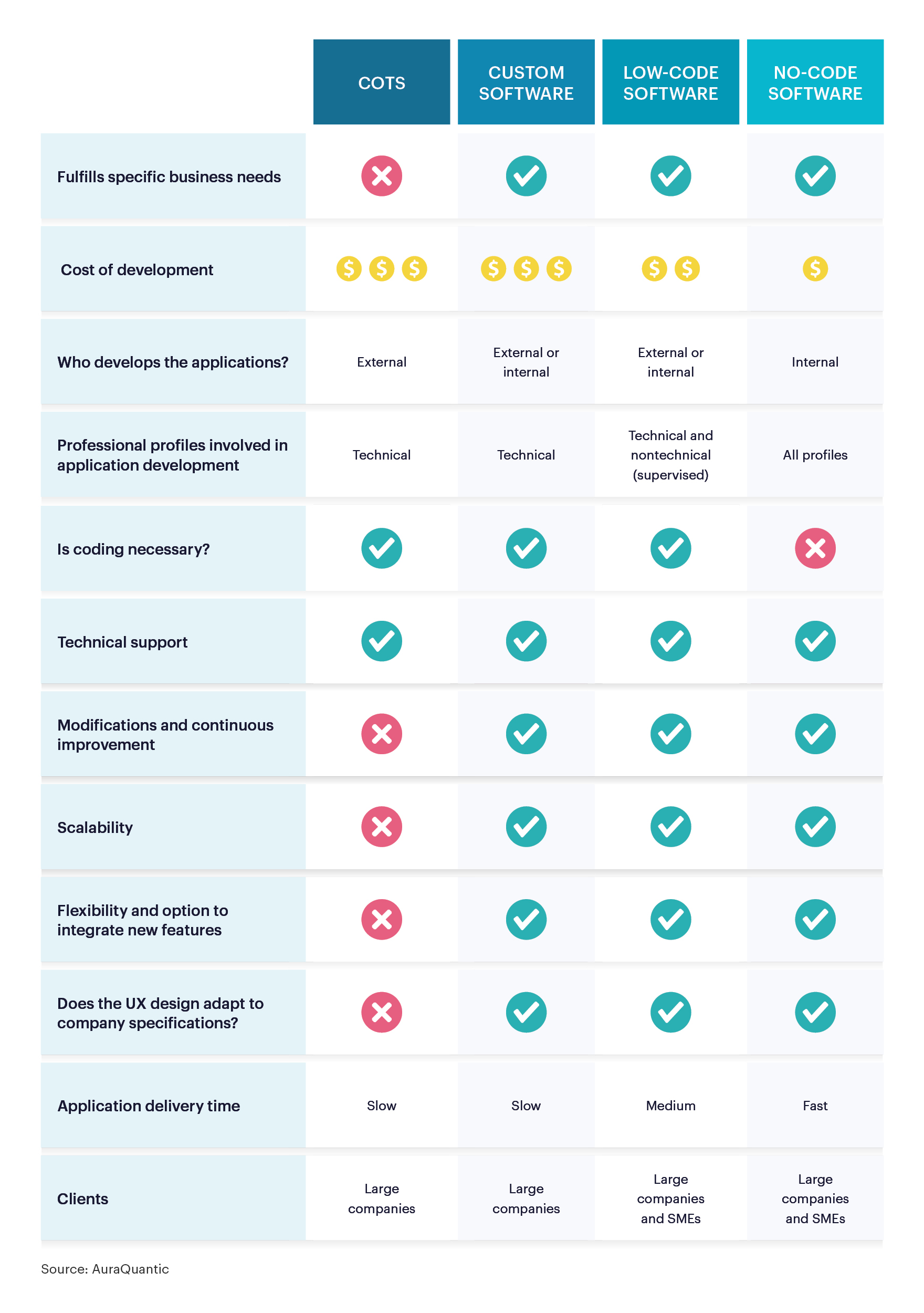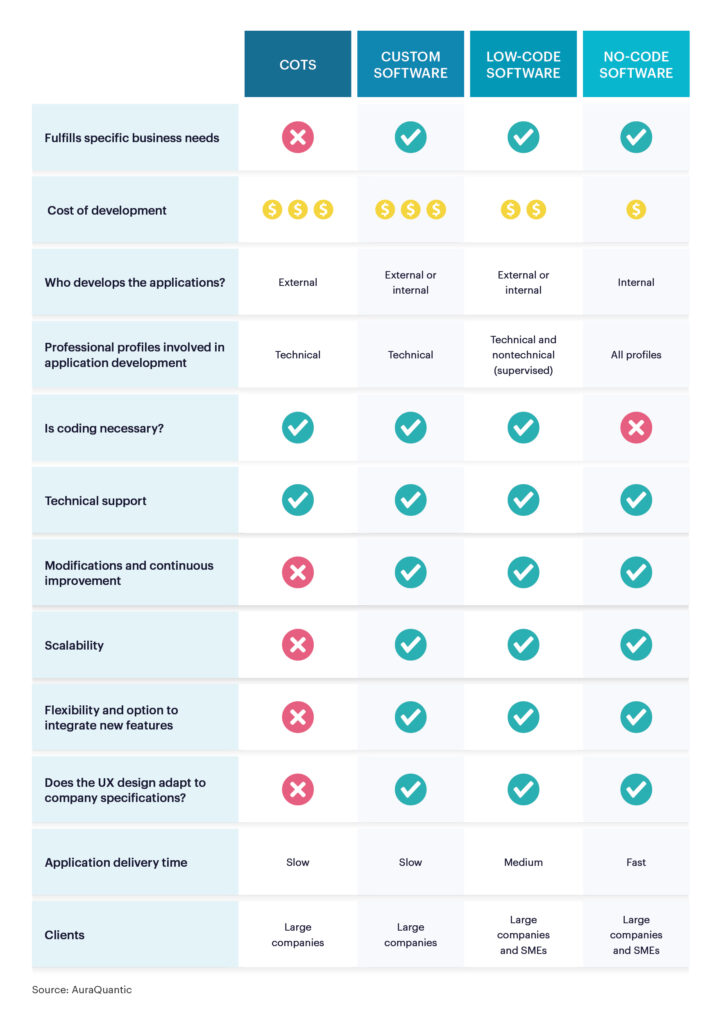Low Code: Building Low Code Applications
Blog: AuraQuantic Blog
Low Code programming is a type of technology used to build applications, minimizing the use of code or programming language. A simple and agile way to create customized software solutions accessible to any organization that is used to drive digital transformation.
The importance of Low Code, considered a technological trend by the industry’s leading IT analyst company, Gartner, lies mainly in the fact that it has democratized software development. This means that any user, with or without specific training in the field of Information Technology (IT), can develop new applications without limits.
Now, could this technology be the end of traditional programming? If you want to know more about this topic and learn more about Low Code technology, do not miss the following article.
How it all began?
Before explaining how Low Code has democratized software development, it is worth pausing for a moment to analyze the origins of this technology. To do this, we will refer to the book Augmented Lean: A Human-Centric Framework for Managing Frontline Operations. It establishes the beginnings of the postwar era as the starting point of Low Code, from the development of software coding languages that begin to share certain similarities with human language. This means that, while “A coder (a person) would write English-like code, and a compiler (a program) would turn code into binary language (zeros and ones), which is what computers understand”.
Subsequently, and approximately 30 years after this period, the evolution of graphical user interfaces, driven by Object Oriented Programming (OOP), progressively permeated software development circles and products. This programming model is characterized by the fact that software design is organized around data or objects, instead of functions and logic. So, an object can be defined as a data field, with unique attributes and behavior.
However, it was not until 2014 that the term ‘Low Code’ was coined by the analyst firm Forrester, in an article written by Clay Richardson and John Rymer, entitled New Development Platforms Emerge For Customer-Facing Applications. The authors define Low Code software as Platforms that enable rapid application delivery with a minimum of hand-coding, and quick setup and deployment, for systems of engagement”.
As the years have gone by, different options have emerged in the software solutions market that incorporate this technology as an alternative for application development, namely Low Code platforms or Low Code development platforms.
Low Code versus other software solutions for application design
Low Code platforms open a new path to software development compared to other traditional alternatives, consisting either of the purchase of commercial off-the-shelf software (COTS) or the development of custom software using a programming language.
In the first case, COTS presents two major limitations related to future adaptation and integration, even though they have been the preferred choice of many companies, as they allow immediate use and do not require differential changes for each client. However, this type of standard or closed solution incorporates multiple functionalities that, in many cases, are not used or adapted to the specific needs of each company. In addition, sometimes COTS require their own developments that the solution itself does not cover. A situation that, in the long term and in the case of having to make a migration, can force the company to eliminate everything developed up to that moment.
On the other hand, custom or ad hoc software is one that is designed and developed to meet specific end-user needs. Therefore, the adaptability of this type of solution to a company’s operation and business processes is one of its main strengths. On the contrary, the fact of having to create the application from scratch using programming code, requires an investment of time, and human and material resources that many companies are not willing to assume.
Low Code technology is especially relevant in the development of ad hoc solutions. This is because it favors the design of applications in a simple way and because it largely replaces the need to create custom code.
However, in recent years another type of technology has emerged that goes beyond Low Code and completely suppresses the use of the programming language. The term used to refer to this technology is No Code. An application development method offered by a small number of software platforms on the market, that have a completely visual work environment. Using a drag-and-drop graphical user interface, both IT professionals and those with a less technical background can design applications by simply dragging and dropping a wide range of pre-built system blocks or components. However, this is just the tip of the iceberg of the myriad benefits offered by No-Code platforms. A technology that goes beyond Low Code, by completely eliminating coding and the need to learn programming languages to build applications.

How has Low Code come to democratize software development?
As we indicated above, the Low Code software development approach is characterized by reduced textual or manual coding. This means that applications can be created with as little manual programming as possible. A characteristic that, in turn, gives its name to the technology and that is the main reason for its widespread use in different types of industries and by different user profiles.
With Low Code, both technical profiles or professional programmers, and business users who do not have IT knowledge, can collaborate in the development of applications. A reality that has served to democratize software development in all types of organizations.
According to the renowned analyst firm Gartner, “Low Code application platforms (LCAP) are expected to remain the largest component of the Low Code development technology market through 2022, increasing nearly 30% from 2020 to reach $5.8 billion in 2021″.
However, No Code is expected to be the new technological trend that will shape the coming years. Such is its importance that, according to Forrester Research, “the total spending on the category is forecasted to hit $21.2 billion by 2022, representing a compound annual growth rate of roughly 40%”. An idea also shared by Gartner, stating, ” By 2025, 70% of new applications developed by organizations will use Low Code or No Code technologies, up from less than 25% in 2020”.
The post Low Code: Building Low Code Applications appeared first on AuraQuantic.
Leave a Comment
You must be logged in to post a comment.









